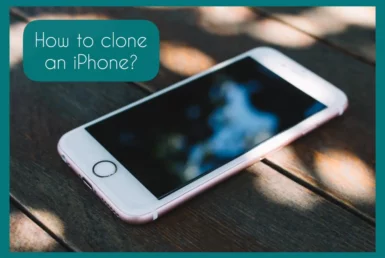Are you trying to figure out if it is possible to clone an iPhone? Replicating an iPhone’s abilities is intriguing in a tech-dominated society.
This article examines the idea of cloning iPhones, looking at the workable methods, the legality, and possible consequences. Stay connected to explore iPhone cloning.
Why Do You Need to Clone an iPhone?
For a variety of reasons, it might be required to clone an iPhone. Protecting important information from unforeseen events like device loss, theft, or damage is one of the main drivers.
Users can guarantee the preservation of priceless images, communications, contacts, and important documents by making a clone.
Furthermore, iPhone cloning may be necessary for data migration to a new device without going through the difficult manual transfer process. Cloning is useful for setting up several devices with the same setups in business settings, which saves time and ensures uniformity across the board.
Even though these justifications highlight how useful cloning is, it’s still important to consider the procedure’s ethical and legal implications to ensure responsible use.
Can You Clone an iPhone?
Yes, it is possible to clone an iPhone, but doing so is difficult and has significant drawbacks. Cloning is the process of precisely copying a device’s data and settings onto another device.
However, it is difficult to completely replicate the hardware and software of an iPhone due to the advanced security mechanisms introduced by Apple, such as encryption and unique device identifiers.
Even though certain third-party programs purport to provide cloning services, they frequently carry hazards like data breaches and voiding warranties. Cloning also creates ethical and legal questions, particularly if done illegally.
Although cloning is technically possible, it is important to understand that it is a challenging and sometimes dangerous effort because of its complex technical challenges and potential drawbacks.
How to Clone an iPhone?
There are several ways to clone an iPhone: copying its data onto another device. Although these techniques are practical, it is important to consider their complex technological requirements, ethical issues, and potential dangers.
Method 1. Quick Start
The Quick Start approach is appropriate when transferring data to a new iPhone. Both devices must be close to each other and use the latest iOS versions to work.
Steps
- Place the new iPhone close to the old one while it is turned on.
- On the new iPhone, sign in using your Apple ID.
- Using the new iPhone’s camera, scan the animation shown on the old one while following the on-screen instructions.
- Set up the new device’s Face ID or Touch ID.
- Select the preferred options for Siri and App Analytics.
- Make the decision to transfer data, then complete the setup.
Method 2. iTunes
You can backup and restore the data on your iPhone using iTunes. This procedure is helpful when moving to a new device or recovering data from a backup.
Steps
- Launch iTunes (or Finder on macOS Catalina and later) after connecting the current iPhone to a computer.
- When the device displays in iTunes or Finder, select it.
- To back up the data on the current iPhone to the computer, select “Back Up Now.”
- Connect the new iPhone and detach the old one after the backup is finished.
- In iTunes or Finder, choose the new device.
- Select the most recent backup from the list by clicking “Restore Backup” and then.
- Await the completion of the process and the restart of the new iPhone with the copied data.
Method 3. iCloud
iCloud offers seamless wireless data transfer and backup. This technique is helpful when establishing a cloud backup and restoring it to an old or new device.
Steps
- Make sure Wi-Fi is active on both iPhones.
- On the older iPhone, go to “Settings” > “[your name] > “iCloud” > “iCloud Backup.”
- To generate an iCloud backup, select “Back Up Now.”
- Follow the setup instructions for the new iPhone until you get to the “Apps & Data” section.
- Enter your Apple ID and choose “Restore from iCloud Backup.”
- Select the most recent backup, then wait until the data is downloaded and restored.
Is It Legal to Clone the iPhone?
Legal and moral issues can frequently arise when cloning an iPhone in the sense of making an exact duplicate of the device’s data and settings.
Cloning an iPhone can be lawful or illegal depending on the circumstances, the goal, and the techniques employed. Here are some important things to think about.
Legitimate Cloning
Data Transfer: Cloning is generally lawful for legitimate reasons, such as transferring data from an old iPhone to a new one utilizing Apple’s services (such as iCloud or iTunes). These procedures have Apple’s approval and are made to be user-friendly.
Illegitimate Cloning
1. Unauthorized Access: Cloning is probably illegal and in breach of privacy regulations if it entails gaining access to someone else’s iPhone without that person’s permission.
2. Getting Around Security: Cloning techniques that entail getting around encryption, security measures, or hacking into the device’s system are deemed illegal hacking or getting around digital security measures.
3. Fraudulent Activities: Cloning for illegal reasons, such as impersonation, identity theft, or financial schemes, is prohibited and could lead to legal action.
It’s important to remember that rules regulating technology and digital devices might differ from one nation to another and even between various regions. Furthermore, Apple’s terms of service and end-user license agreements may limit specific cloning-related actions.
Conclusion
In a world where technology rules, the idea of cloning iPhones is appealing. Although possible, the procedure’s complexity, ethical issues, and potential legal repercussions make it a challenging task. Since the legality of cloning differs depending on intent and process, it is vital to strike a balance between convenience and responsible use.

